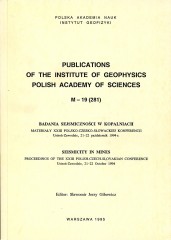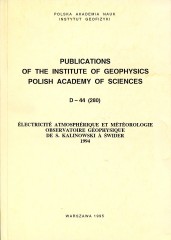BROWSE - VOLUME LIST
- A - Physics of the Earth's Interior
- B - Seismology
-
C - Geomagnetism
C-119, C-118, C-117, C-116, C-115, C-114, C-113, C-112, C-111, C-110, C-109, C-108, C-107, C-106, C-105, C-104, C-103, C-102, C-101, C-100, C-99, C-98, C-97, C-96, C-95, C-94, C-93, C-92, C-91, C-90, C-89, C-88, C-87, C-86, C-85, C-84, C-83, C-82, C-81, C-80, C-79, C-78, C-77, C-76, C-75, C-74, C-73, C-72, C-71, C-70, C-69, C-68, C-67, C-66, C-65, C-64, C-63, C-62, C-61, C-60, C-59, C-58, C-57, C-56, C-55, C-54, C-53, C-52, C-51, C-50, C-49, C-48, C-47, C-46, C-45, C-44, C-43, C-42, C-41, C-40, C-39, C-38, C-37, C-36, C-35, C-33, C-32, C-31, C-30, C-29, C-28, C-27, C-26, C-25, C-24, C-23, C-22, C-21, C-20, C-19, C-18, C-17, C-16, C-15, C-14, C-13, C-12, C-11, C-10, C-9, C-8, C-7, C-6, C-5, C-4, C-3, C-2, C-1
-
D - Physics of the Atmosphere
D-79, D-78, D-77, D-76, D-75, D-74, D-73, D-72, D-71, D-70, D-69, D-68, D-67, D-66, D-65, D-64, D-63, D-62, D-61, D-60, D-59, D-58, D-57, D-56, D-55, D-54, D-53, D-52, D-51, D-50, D-49, D-48, D-47, D-46, D-44, D-45, D-43, D-42, D-41, D-40, D-39, D-38, D-37, D-35, D-34, D-33, D-32, D-31, D-30, D-28, D-27, D-26, D-25, D-24, D-23, D-22, D-21, D-20, D-19, D-18, D-17, D-16, D-15, D-14, D-13, D-12, D-11, D-10, D-9, D-8, D-7, D-6, D-5, D-4, D-3, D-2, D-1
- E - Hydrology
- P - Polar Research
- M - Miscellanea
-
Online First
Browse - Volume list
Badania Sejsmiczności w Kopalniach. Materiały XXIII Polsko-Czesko-Słowackiej Konferencji, Ustroń-Zawodzie, 21-22 październik 1994 r. *** Seismicity in Mines. Proceedings of the XXIII Polish-Czech-Slovakian Conference, Ustroń-Zawodzie, 21-22 October 1994
Editor(s): Gibowicz S.
Volume: 281
Series: M-19
Volume: 281
Series: M-19
The XXIII Polish-Czech-Slovakian Conference on Seismicity in Mines was held on 21-22 October 1994, this time in Poland, in Ustroń-Zawodzie in the Beskidy Mts. The meeting was attended by 78 participants from Poland and 13 participants from the Czech Republic. A number of research institutions as well as several coal and copper mines were represented. Forty-one papers were presented, describing the results of research on various aspects of seismicity induced by mining. As a result of gradual introduction of modern digital equipment for seismic monitoring in mines, a growing interest in source mechanism studies of mining tremors should be noted. Apart from a classic form of fault-plane solutions based on the first-motion observations, a more general form based on moment tensor inversion is introduced, together with source parameters based on spectral analysis of the recorded seismic waves. A number of papers on these topics were presented and discussed.
Electricite Atmospherique et Meteorologie Observatoire Geophysique de S. Kalinowski a Swider 1994
Author(s): Warzecha S., Kubicki M.
Volume: 280
Series: D-44
Volume: 280
Series: D-44
The present issue contains the results of recordings of some elements of atmospheric electricity and daily observations of major meteorological factors noted at the S. Kalinowski Geophysical Observatory of the Polish Academy of Sciences at Świder in 1994. Data for the years 1957-1965 have been published in "Prace Obserwatorium Geofizycznego im. S. Kalinowskiego w Świdrze" and for 1966-1994 in "Publications of the Institute of Geophysics, Polish Academy of Sciences".
Atmospheric Ozone, Solar Radiation, 1994
Author(s):
Volume: 279
Series: D-45
Volume: 279
Series: D-45
Ozone observations have been made by means of Dobson spectrophotometer No. 84 in the Geophysical Observatory at Belsk since March 1963. This publication presents all total ozone values and vertical distribution of ozone over Belsk in 1994 obtained from the conventional Umkehr observations.
Results of Geomagnetic Observations, Hel Geophysical Observatory 1994
Author(s): Czyszek A., Czyszek J.
Volume: 278
Series: C-56
Volume: 278
Series: C-56
This volume contains the results of observations of the Earth magnetic field for the year 1994, carried out at the Geophysical Observatory at Hel near Gdańsk. It is a consecutive 17-th report of similar results published since 1966.
Results of Geomagnetic Observations, Belsk 1994
Author(s): Marianiuk J.
Volume: 277
Series: C-55
Volume: 277
Series: C-55
The publication contains results of geomagnetic observations performed in 1994; it is a consecutive, 29-th issue in the series of yearbooks listing observations of the natural magnetic field of the Earth at the Central Geophysical Observatory at Belsk.






